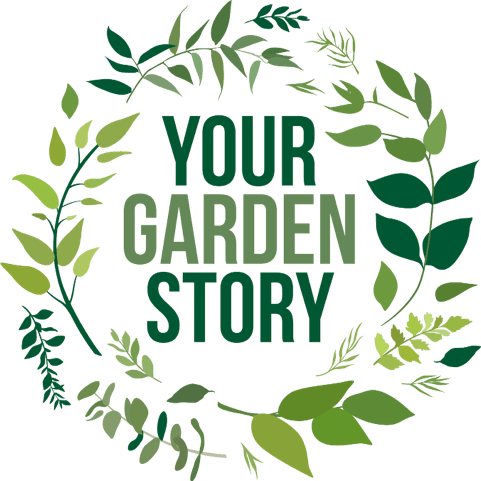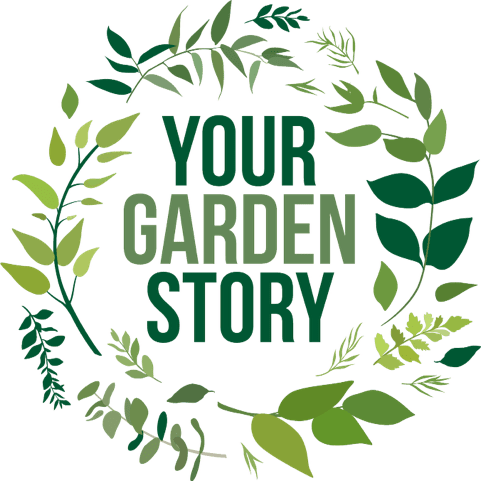Your Garden Story launched with the belief that we can all become gardeners and make this world greener. My work with the Gowanus Canal Conservancy opened my mind to the idea that we can all be stewards of our green spaces, big or small. We make decisions about how we garden and what we plant, and it’s fun to discover how we can make those spaces wildlife-friendly and sustainable. Friends, family and clients ask me for advice on using native plants in their gardens. There are so many excellent resources on why plant native and types of native plants, but much less information on how to start integrating native plants into your garden as a beginner. Not everyone has a garden big enough to embrace the scope and range of native plants. If that’s the case for you, or you want to learn more about native plants before committing them to your garden beds, then container gardening with native plants is a great way to start. You can either plant up a container exclusively with native plants or do what I often do, which is combine native and exotic plants.

I guarantee it will start you on a beautiful journey of discovery and sustainability in no time. This blog is all about native plant containers since spring is the perfect time to start.
Before we get into what plants to buy, here is a reminder of what we mean by native plants. The Audubon Trust definition is, “Native plants are those that occur naturally in a region in which they evolved. They are the ecological basis upon which life depends, including birds and people. Without them and the insects that co-evolved with them, local birds cannot survive”. Our wildlife depends on native plants for food and shelter, and using native plants provides many more species of birds, butterflies and other wildlife with shelter than exotic plants. They also save you time. They need less watering because they are adapted to their growing environment and are more disease-resistant. We don’t need any more convincing, do we, that native plants make a big difference?
To start with – choose Your Container
To create your native habitat, find a large, expansive container; something around 15″ deep and maybe 20″ wide would work well. You want to give your plants a good depth of soil, and a larger container for natives means they require less frequent watering. You might well have a container in the garden that you can use, switch up an existing one you usually use for exotic plants or annuals, or take the opportunity to buy a new container or two. Use a frost-proof container so your plants can winter over without cracking the pot. I make no excuse for mentioning my favourite suppliers at the moment. Seibert & Rice make handmade terracotta planters and urns. Made in Italy, their terracotta pots are frostproof and can last unscathed in NE cold winters.
I also love Bergs Potter, which makes beautiful indoor and outdoor terracotta pots designed to help your plants thrive. Your Garden Story has a fantastic range of indoor and outdoor planters from Bergs this spring. Take a look at the Your Garden Story site Your Garden Story to see what’s in stock. Available for pick up and local delivery if you live in the NY city or CT area.
Think about your soil
Depending on your region’s temperature and humidity, you should use lightweight soil that drains well but can also retain moisture for container planting. Commercial mixes are the most straightforward to use. They generally have long-lasting organic matter to keep the soil fresh for a few years and often contain fertilizer to extend life.
Keep The Design Simple
- Select a tall plant (a THRILLER)
- A plant that fills the pot (a FILLER),
- And a plant that spills out over the edge (a SPILLER).
With this straightforward recipe, you can quickly create an attractive and pollinator-friendly container. Use your imagination when you think about what natives to plant, but remember never to dig up wild plants, thinking they will thrive in your garden/container. Always buy your plants or seeds from a reputable native plant nursery. Here are some I recommend on both sides of the Atlantic.

Lowlands Nursery sells native plants adapted to the urban conditions of Gowanus, NYC. Run by the Gowanus Canal Conservancy, the nursery is mission-driven, and the proceeds support its education and stewardship initiatives.
Glover Perennials is a wholesale-only nursery that grows perennials, woodies, vines, and native ornamentals. They offer a vast selection of native plants, with over 220 from the Northeastern US. They produce most of their plants, and the nursery is a fantastic place to visit and explore their extensive collections.
Earth Tones is a native plant nursery in Woodbury, CT. It offers grasses, ferns, perennials, shrubs, and trees native to New England. Earth Tones is open to the public.
Beth Chatto (UK) With over 2,000 varieties, most plants sold at Beth Chatto are grown on-site. Referencing Beth’s famous soundbite, right plant, right place, plants are sold based on their preferred growing conditions. Along with exotic perennials, Beth Chatto sells many plants native to the UK. The gardens are also worth a visit for inspiration and education.
Think about your plant selection
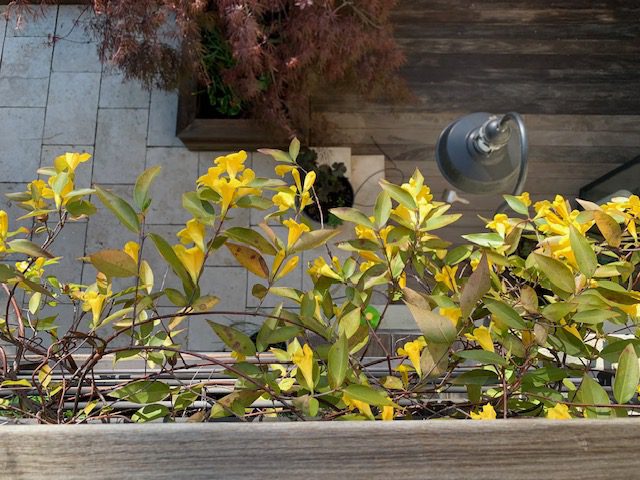
â— Biomass (stems/twigs/leaves) created by small shrubs, vines, grasses, and herbaceous plants give good cover for nesting sites and food for wildlife and are best created by plants that have a lot of growth above the soil in relation to their roots. So vines that can be trained up walls to create living screens work well, as do tall perennials with plenty of foliage/breadth. A few years ago, I planted Gelsemium sempervirens ‘Margarita’ in a container on my deck, along with Agastache and a couple of exotics. Together, they attract bees and birds to the deck in abundance. The vine extends along the deck, has beautiful yellow flowers in spring and provides a screen for birds to feed from the seed heads.
â— Choose an assortment of plants that bloom in different seasons to provide lots of seasonal interest and a reason for wildlife to return to your habitat throughout the year.
â— Buy the primary species of the plant where you can; cultivars are not necessarily created with wildlife needs in mind but be flexible. You can’t always find the primary species.
â— Always use grasses; they are great fillers and give the container some textural interest.
Sun loving natives combinations for containers
Grasses love a sunny position and work well in sun-loving containers. For extended seasons of color, try Purple lovegrass (Eragrostis spectabillis) combined with Black-eyed Susan, (Rudbeckia fulgia) and Skyblue aster (Symphyotrichu oolentangienese).
It’s fun to use Purple coneflower (Echinacea purpurea) in a container along with Purple lovegrass and Blazing star (Liatris aspera). You could also use Palm sedge (Carex muskingumensis) as an alternative to the grass or use both!!
I have tried Aster Bluebird as the focal point for a sunny container along with Threadleaf coreopsis (Coreopsis verticillata) as the filler and Moss phlox (Phlox subulata) as the spiller. A lovely flower-heavy combination gives you something in bloom all spring, summer, and early fall.
Shade loving native combinations for containers
Hairy alum root (Heuchera villosa) is great in shade containers as a spiller. It has excellent foliage that works well combined with a floral plant with great impact. I have used a cultivar, Heuchera Coral Bells, where the straight species wasn’t available. The dark leaves look amazing with the native Gaillardia (Blanket flower) combined with exotic Violas and Bellis perennis, Common daisy.
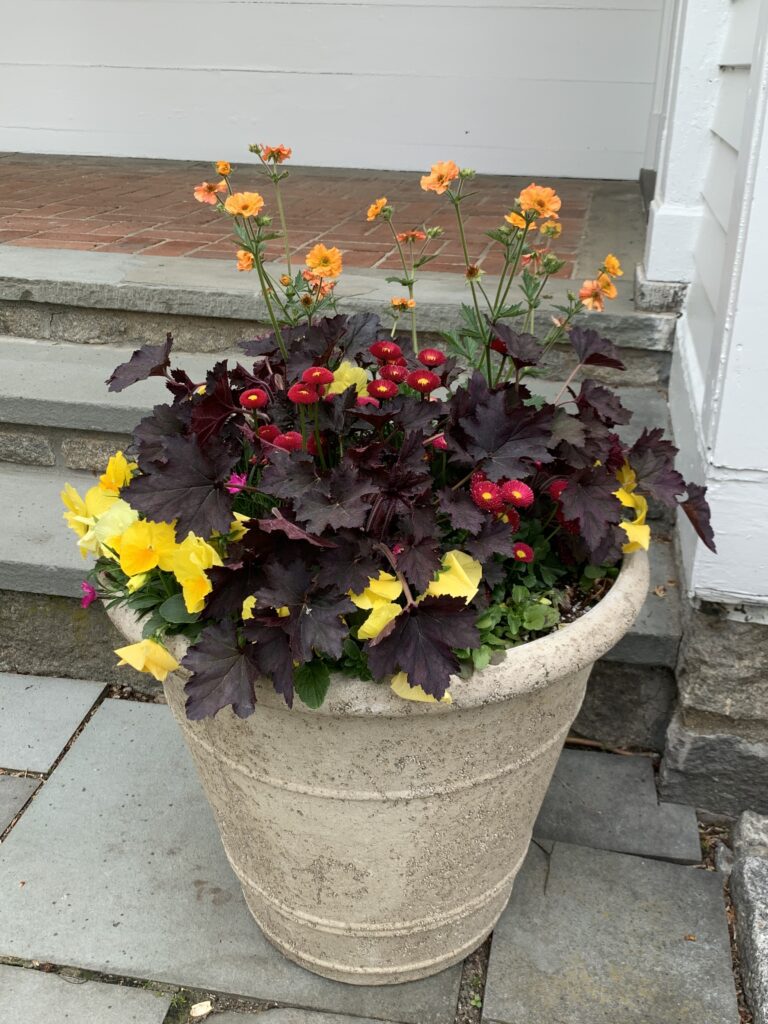
Another great shade combination utilizes ferns. The Ostrich fern (Mattechia strutheropteris) combined with Virginia bluebells (Mertenisia virginiana) looks amazing. Add Zizia or Coreopsis for some more color pop.
Top tips for managing your containers after planting
Drainage for Native containers
Drainage is always essential for containers, mainly when plants are in containers over multiple seasons. Be sure you have ample drainage holes, and put some gravel or large pieces of stone in the bottom to stop the holes from clogging. Pot feet are an absolute requirement.
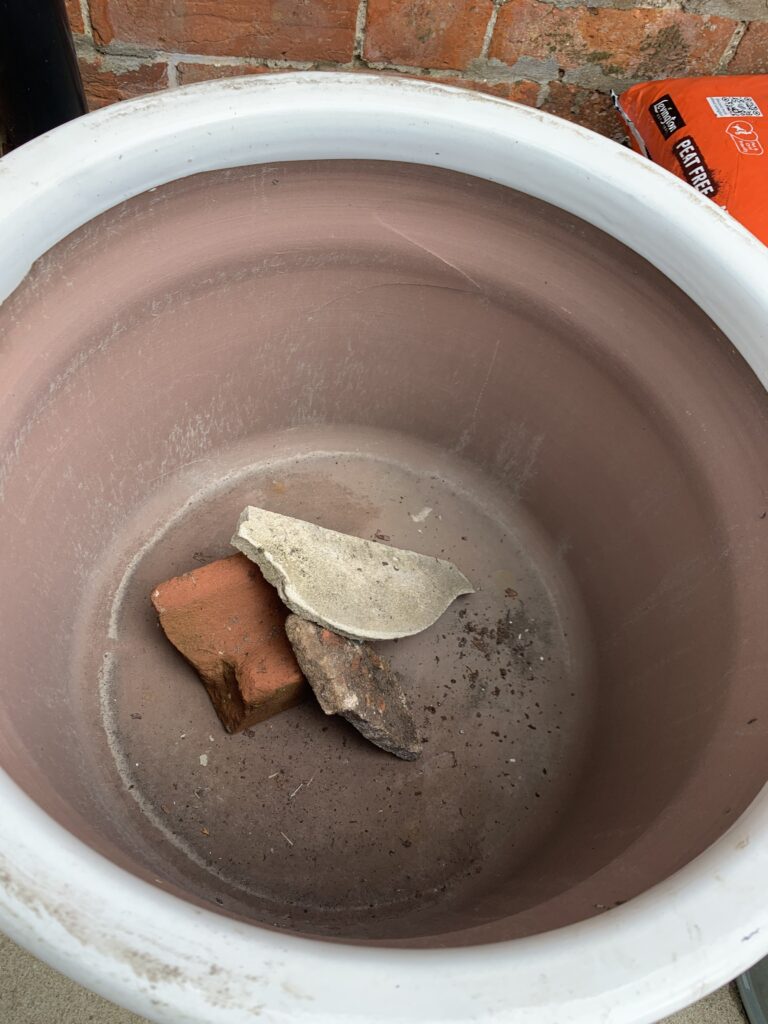

Maintenance
Don’t deadhead the flowers however much your instinct tells you to. Keep the foliage picked clean if it dies, but leave the flowers on to produce seeds for the birds.
Fertiliser
Fertilization is essential after the first year when many nutrients are depleted from growing for an entire season. I use a solution of water and liquid fertilizer mixed up in a watering can for easy application.
I hope you have been inspired to try natives in containers. Like so many aspects of gardening, it’s good to experiment and see what works in your garden. Native perennials in containers can also be easily transferred to your garden beds at a later stage. You can find more inspiration by going to the Lady Bird Johnson Wildflowers. The Royal Horticultural Society in the UK has also written a very informative book, Greener Gardening: Containers, a helpful resource, RHS Green Gardening.
Get in touch
Get in touch if you want more information on items included on my website or need help sourcing plants or containers at [email protected]. My Garden Story is here to help bring out the gardener in all of us.
